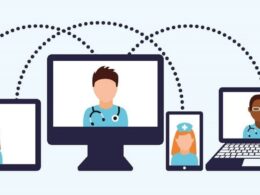This is an excerpt of the publication below, focusing on the theme above.
For the full version of the original article, please refer to the original publication.
The Telehealth Era Is Just Beginning
Harvard Business Review
by Robert Pearl, Brian Wayling
From the Magazine (May–June 2022)
Excerpt by
Joaquim Cardoso MSc
Health Revolution Institute
Telehealth Revolution Unit
April 16, 2022
What is the context?
- Contrary to what many people think, virtual health care, also known as telemedicine or telehealth, is much more than a cheap digital knockoff of in-person care.
- When used appropriately, it improves patient health, reduces costs, and makes care more equitable and accessible to anyone with a smartphone.
- Its use has soared during the Covid era — and the authors argue that providers around the world should aggressively strive to tap its full potential even after the pandemic abates.
What is the message?
In this article we take an inside look at two of telemedicine’s earliest adopters and most effective users:
- Kaiser Permanente, where one of us (Robert) was CEO; and
- Intermountain Healthcare, where the other (Brian) is an executive director of telehealth services.
For more than a decade these integrated health systems have used virtual care platforms to improve preventive medicine, care coordination, chronic disease management, and affordability for more than 13 million patients.
What are the 5 opportunities?
- Opportunity 1: Reduce Expensive and Unnecessary Trips to the ER
- Opportunity 2: Reverse America’s Chronic-Disease Crisis
- Opportunity 3: Address Disparities in Health Care
- Opportunity 4: Make Specialty Care Faster and More Efficient
- Opportunity 5: Provide Access to the Best Doctors
What is the business case?
Full implementation of five opportunities would:
- improve clinical quality nationwide by 20%,
- increase access to care by 20%, and
- reduce health care spending by 15% to 20%.

Opportunity #5: Provide Access to the Best Doctors
Patients with obscure or complex medical problems often find themselves living a two-pronged nightmare.
There’s the pain and fear of having a rare disease and the frustration of trying to find the right specialist.
Patients may bounce from one local physician to the next, wasting weeks or months sitting through useless appointments and enduring sleepless nights.
Telemedicine offers a far better solution.
Virtual technology can connect patients with the most experienced and knowledgeable doctors regardless of where they practice.
This scenario is already playing out in Kaiser Permanente’s Northern California region.
A nationally renowned expert in kidney cancer is located in a remote corner of Marin County, nearly 200 miles from some KP members.
Newly diagnosed patients can meet with him virtually. During video consultations he educates them about their condition, using visual aids on a shared screen.
He walks them through the relevant clinical information, their radiological scans, and treatment options.
He shares videos of the anatomy and the anticipated surgical procedure.
Given the rapport thus established, nearly all patients choose to have him perform their surgery, despite the distance many must travel; the day of the operation is often the first time both parties are in the same room. The doctor’s patient-satisfaction scores are universally excellent.
Intermountain uses telemedicine to connect patients who have complex (and often very costly) neurological conditions with specialists.
Its Neuro Fast Access Clinical Team virtual platform enables them to receive treatment for migraines, low back pain, and neck pain from an expert at a low cost, in the process freeing up valuable clinical time for patients who require in-person treatment, such as Botox injections for nerve and muscle diseases.
By eliminating the barriers of time and distance, telemedicine can help address two serious problems for patients with difficult diagnoses and rare diseases.
- The first is misdiagnosis.
- The second is long waits for a proper diagnosis and effective treatment plan.
Doctors must often attempt an impossible balancing act with respect to quality, access, and cost.
When they increase access to care, costs rise. When they cut costs, quality suffers. The rise of telemedicine during the pandemic spotlights a way to provide rapid access to affordable, high-quality care.
Increasing both the frequency and the scope of virtual care nationwide would transform American health, improving the lives of patients who get sick during nights and weekends, those with chronic and mental health issues, and anyone who could benefit from virtual specialty care.
It could save tens of thousands of lives and hundreds of billions of dollars each year.
Increasing both the frequency and the scope of virtual care nationwide would transform American health, improving the lives of patients who get sick during nights and weekends, those with chronic and mental health issues, and anyone who could benefit from virtual specialty care.
It could save tens of thousands of lives and hundreds of billions of dollars each year.
A version of this article appeared in the May-June 2022 issue of Harvard Business Review.
Originally published at https://hbr.org on May 1, 2022.












